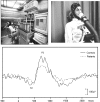Scents and nonsense: olfactory dysfunction in schizophrenia
- PMID: 19793796
- PMCID: PMC2762633
- DOI: 10.1093/schbul/sbp111
Scents and nonsense: olfactory dysfunction in schizophrenia
Abstract
Among the sensory modalities, olfaction is most closely associated with the frontal and temporal brain regions that are implicated in schizophrenia and most intimately related to the affective and mnemonic functions that these regions subserve. Olfactory probes may therefore be ideal tools through which to assess the structural and functional integrity of the neural substrates that underlie disease-related cognitive and emotional disturbances. Perhaps more importantly, to the extent that early sensory afferents are also disrupted in schizophrenia, the olfactory system-owing to its strategic anatomic location-may be especially vulnerable to such disruption. Olfactory dysfunction may therefore be a sensitive indicator of schizophrenia pathology and may even serve as an "early warning" sign of disease vulnerability or onset. In this article, we review the evidence supporting a primary olfactory sensory disturbance in schizophrenia. Convergent data indicate that structural and functional abnormalities extend from the cortex to the most peripheral elements of the olfactory system. These reflect, in part, a genetically mediated neurodevelopmental etiology. Gross structural and functional anomalies are mirrored by cellular and molecular abnormalities that suggest decreased or faulty innervation and/or dysregulation of intracellular signaling. A unifying mechanistic hypothesis may be the epigenetic regulation of gene expression. With the opportunity to obtain olfactory neural tissue from live patients through nasal epithelial biopsy, the peripheral olfactory system offers a uniquely accessible window through which the pathophysiological antecedents and sequelae of schizophrenia may be observed. This could help to clarify underlying brain mechanisms and facilitate identification of clinically relevant biomarkers.
Figures







References
-
- Saykin AJ, Shtasel DL, Gur RE, et al. Neuropsychological deficits in neuroleptic naive patients with first-episode schizophrenia. Arch Gen Psychiatry. 1994;51:124–131. - PubMed
-
- Turetsky B, Cowell PE, Gur RC, Grossman RI, Shtasel DL, Gur RE. Frontal and temporal lobe brain volumes in schizophrenia. Relationship to symptoms and clinical subtype. Arch Gen Psychiatry. 1995;52:1061–1070. - PubMed
-
- Schneider F, Habel U, Reske M, Toni I, Falkai P, Shah NJ. Neural substrates of olfactory processing in schizophrenia patients and their healthy relatives. Psychiatry Res. 2007;155:103–112. - PubMed
-
- Seckinger RA, Goudsmit N, Coleman E, et al. Olfactory identification and WAIS-R performance in deficit and nondeficit schizophrenia. Schizophr Res. 2004;69:55–65. - PubMed
Publication types
MeSH terms
Grants and funding
LinkOut - more resources
Full Text Sources
Medical

